Experimental Research on the Impactive Dynamic Effect of Gas-Pulverized Coal of Coal and Gas Outburst
Abstract
:1. Introduction
2. Experimental Equipment and Program
2.1. Experimental Equipment and Features
- (1)
- Dynamic effect container is key component of the coal and gas outburst dynamic simulation test device, and it is used to simulate the coal and gas occurrence in the outburst hole and launch the outburst. The volume is 1.88 m3 and the maximum working pressure is 5.0 MPa. There are two coal loading ports on the top of the container for filling solid experimental materials; sensor ports and gas-filled holes is on the sides; and a 300 mm diameter outburst port is on the front bottom. Before the test, the outburst port was sealed by two rupture disks. It was used to control the pressure difference between the two sides of the rupture disk to achieve the opening of the outburst port.
- (2)
- Gas injection sub-system consists of controller, high-pressure cylinder group, and vacuum pump. It used to achieve accurate control of test gas pressure.
- (3)
- Roadway sub-system is mainly used for the simulation of the mine tunnel network and consists of 4 types of 6 pipe assemblies including straight pipe assembly (1.0 m, 1.5 m), tee pipe assembly, right angle pipe assembly and inclined pipe assembly (10°, 20°). Available connect by rubber mats and screws, total length up to 50 m. The cross-sectional shape is a square with an internal size of 300 mm × 300 mm. A number of sensor contacts, visible windows, and cleaning windows are provided for ease of test placement, testing, and cleaning.
- (4)
- Data monitoring and acquisition sub-system is mainly used to collect experimental data, including gas pressure, temperature, gas concentration, wind speed, etc. It has two modes: low-speed acquisition and high-speed acquisition. It can automatically switch to high-speed acquisition mode at outburst moment to ensure complete and reliable data. Its highest sampling rate is 4 MS/s.
- (5)
- The main structure of the dust removal sub-system is made of a steel plate with a thickness of 8 mm. The overall length is 3 m, width is 2 m, and height is 4 m. Dust removal is carried out by means of cloth bag filtration, to avoid polluting the surrounding environment. It was started when finish the collection and sorting of the distribution data of roadway pulverized coal after the end of the test. The main structural components include: cylinders, vent pipes, ladders, ash doors, etc. The interior of the cylinder is equipped with dust removal facilities such as filter cartridges, vibrators, and gaskets.
2.2. Experimental Program
3. Experimental Result
3.1. Evolution Law of Gas Pressure in Roadway
3.2. Evolution Law of Temperature in Roadway
3.3. Evolution law of CO2 Concentration in Roadway
3.4. The Migration Rule of Pulverized Coal in Roadway
4. The Shock Wave Propagation Mechanism of the Coal and Gas Outburst
4.1. Expansion Energy of Gas in the Outburst Process
4.2. The Shock Wave Propagation Law of Outburst
5. Conclusions
- (1)
- After the outburst occurred, the air in the roadway around the outburst port was disturbed by the shock wave, and the pressure and temperature were abruptly changed. The pressure in different locations of the roadway eventually went back to the initial value after repeated fluctuations. In initial gas pressure of 0.35 MPa, the overpressure of the outburst shock wave was about 20~35 kPa, and the overpressure in the main roadway and the distance from the outburst port showed a decreasing trend, while the overpressure in the branch roadway increased with distance due to the reflection effect of shock wave. The change rates of temperature and gas concentration in the experiment were relatively slow than that of the gas pressure. The highest temperature in the roadway increased by 0.25 °C and the highest concentration reached 38.12%.
- (2)
- A total weight of 180.7 kg pulverized coal was erupted in this experiment, most of them accumulated in the main roadway. With the action of shock air flow, the pulverized coal transportation in the roadway could be roughly divided into the accelerated movement stage, decelerated movement stage and the particle settling stage. At the late process of outburst, pulverized coal transport rate decreased with time. In the late process of decelerate movement stage, it accompanied by the settlement process.
- (3)
- Through analyzing the law of outburst shock wave propagation, a shock wave propagation model considering the gas desorption efficiency was constructed. The relationships between shock wave overpressure and outburst intensity, gas desorption rate, initial gas pressure, cross section and distance of the roadway were obtained. Under the test conditions, the overpressure of the shock wave was quadratic with the fitting parameter b (affected by gas desorption rate).
Acknowledgments
Author Contributions
Conflicts of Interest
References
- Li, Z.H.; Wang, E.Y.; Ou, J.C.; Liu, Z.J. Hazard evaluation of coal and gas outbursts in a coal-mine roadway based on logistic regression model. Int. J. Rock Mech. Min. Sci. 2015, 80, 185–195. [Google Scholar] [CrossRef]
- Liu, H.B.; Cheng, Y.P. The elimination of coal and gas outburst disasters by long distance lower protective seam mining combined with stress-relief gas extraction in the Huaibei coal mine area. J. Nat. Gas Sci. Eng. 2015, 27, 346–353. [Google Scholar] [CrossRef]
- Yuan, L. Control of coal and gas outbursts in Huainan mines in China: A review. J. Rock Mech. Geotech. Eng. 2016, 8, 559–567. [Google Scholar] [CrossRef]
- Ma, D.J.; Li, Z.H.; Yang, Y.L.; Tang, Y.B.; Jiang, M.M. Research on coal and gas outburst accident of Xinxing coal mine based on shock wave theory. J. Safety Sci. Technol. 2012, 8, 69–73. (In Chinese) [Google Scholar]
- Hu, Q.T.; Wen, G.C. Mechanical Mechanism of Coal and Gas Outburst; China Science Press: Beijing, China, 2013; pp. 227–285. (In Chinese) [Google Scholar]
- Sato, K.; Fujii, Y. Source Mechanism of a Large Scale Gas Outburst at Sunagawa Coal Mine in Japan. Pure Appl. Geophys. 1989, 129, 325–343. [Google Scholar] [CrossRef]
- Fisne, A.; Esen, O. Coal and gas outburst hazard in Zonguldak Coal Basin of Turkey, and association with geological parameters. Nat. Hazards 2014, 74, 1363–1390. [Google Scholar] [CrossRef]
- Zhai, C.; Xiang, X.W.; Xu, J.Z.; Wu, S.L. The characteristics and main influencing factors affecting coal and gas outbursts in Chinese Pingdingshan mining region. Nat. Hazards 2016, 82, 507–530. [Google Scholar] [CrossRef]
- Xu, T.; Tang, C.A.; Yang, T.H.; Zhu, W.C.; Liu, J. Numerical investigation of coal and gas outbursts in underground collieries. Int. J. Rock Mech. Min. Sci. 2006, 43, 905–919. [Google Scholar] [CrossRef]
- Xu, S.; Wang, Y.C.; Xie, J.; Wang, G. A coupled approach to simulate initiation of outbursts of coal and gas—Model development. Int. J. Coal Geol. 2011, 86, 222–230. [Google Scholar] [CrossRef]
- Alexeev, A.D.; Revva, V.N.; Alyshev, N.A.; Zhitlyonok, D.M. True triaxial loading apparatus and its application to coal outburst prediction. Int. J. Coal Geol. 2004, 58, 245–250. [Google Scholar] [CrossRef]
- Sobczyk, J. The influence of sorption processes on gas stresses leading to the coal and gas outburst in the laboratory conditions. Fuel 2011, 90, 1018–1023. [Google Scholar] [CrossRef]
- Skoczylas, N. Laboratory study of the phenomenon of methane and coal outburst. Int. J. Rock Mech. Min. Sci. 2012, 55, 102–107. [Google Scholar] [CrossRef]
- Sobczyk, J. A comparison of the influence of adsorbed gases on gas stresses leading to coal and gas outburst. Fuel 2014, 115, 288–294. [Google Scholar] [CrossRef]
- Peng, S.J.; Xu, J.; Yang, H.W.; Liu, D. Experimental study on the influence mechanism of gas seepage on coal and gas outburst disaster. Saf. Sci. 2012, 50, 816–821. [Google Scholar] [CrossRef]
- Yin, G.Z.; Jiang, C.B.; Wang, J.G.; Xu, J.; Zhang, D.M.; Huang, G. A New Experimental Apparatus for Coal and Gas Outburst Simulation. Rock Mech. Rock Eng. 2016, 49, 2005–2013. [Google Scholar] [CrossRef]
- Geng, J.B.; Xu, J.; Nie, W.; Peng, S.J.; Zhang, C.L.; Luo, X.H. Regression analysis of major parameters affecting the intensity of coal and gas outbursts in laboratory. Int. J. Min. Sci. Technol. 2017, 27, 327–332. [Google Scholar] [CrossRef]
- Tu, Q.Y.; Cheng, Y.P.; Guo, P.K.; Jiang, J.Y.; Wang, L.; Zhang, R. Experimental Study of Coal and Gas Outbursts Related to Gas-Enriched Areas. Rock Mech. Rock Eng. 2016, 49, 3769–3781. [Google Scholar] [CrossRef]
- Zhao, W.; Cheng, Y.P.; Jiang, H.N.; Jin, K.; Wang, H.F.; Wang, L. Role of the rapid gas desorption of coal powders in the development stage of outbursts. J. Nat. Gas Sci. Eng. 2016, 28, 491–501. [Google Scholar] [CrossRef]
- Xu, L.H.; Jiang, C.L. Initial desorption characterization of methane and carbon dioxide in coal and its influence on coal and gas outburst risk. Fuel 2017, 203, 700–706. [Google Scholar] [CrossRef]
- Otuonye, F.; Sheng, J. A numerical simulation of gas flow during coal/gas outbursts. Geotech. Geol. Eng. 1994, 12, 15–34. [Google Scholar] [CrossRef]
- Fedorov, A.V.; Fedorchenko, I.A. Numerical modeling of the coal-and-gas outburst gasdynamics. J. Min. Sci. 2010, 46, 473–484. [Google Scholar] [CrossRef]
- Fedorchenko, I.A.; Fedorov, A.V. Gas-Dynamic Stage of the Coal and Gas Outburst with Allowance for Desorption. J. Min. Sci. 2012, 48, 15–26. [Google Scholar] [CrossRef]
- Sun, D.L.; Hu, Q.T.; Miao, F.T. Motion state of coal-gas flow in the process of outburst. J. China Coal Soc. 2012, 37, 452–458. (In Chinese) [Google Scholar]
- Miao, F.T.; Sun, D.L.; Hu, Q.T. The formation mechanism of shock waves in the coal and gas outburst process. J. China Coal Soc. 2013, 38, 367–372. (In Chinese) [Google Scholar]
- Zhao, W.; Cheng, Y.P.; Guo, P.K.; Jin, K.; Tu, Q.Y.; Wang, H.F. An analysis of the gas-solid plug flow formation new insights into the coal failure process during coal and gas outbursts Original. Powder Technol. 2017, 305, 39–47. [Google Scholar] [CrossRef]
- Wang, K.; Zhou, A.T.; Zhang, J.F.; Zhang, P. Real-time numerical simulations and experimental research for the propagation characteristics of shock waves and gas flow during coal and gas outburst. Saf. Sci. 2012, 50, 835–841. [Google Scholar] [CrossRef]
- Zhou, A.T.; Wang, K.; Wang, L.; Du, F.; Li, Z.L. Numerical simulation for propagation characteristics of shock wave and gas flow induced by outburst intensity. Int. J. Min. Sci. Technol. 2015, 25, 107–112. [Google Scholar] [CrossRef]
- Cao, J.; Sun, H.T.; Dai, L.C.; Sun, D.L.; Wang, B.; Miao, F.T. Simulation research on dynamic effect of coal and gas outburst. J. China Univ. Min. Technol. 2018, 47, 100–107. (In Chinese) [Google Scholar]
- Wang, X.S.; Xie, Z.K. A discussion on the safety distance in case of gas explosion. J. China Univ. Min. Technol. 1989, 18, 1–8. (In Chinese) [Google Scholar] [CrossRef]
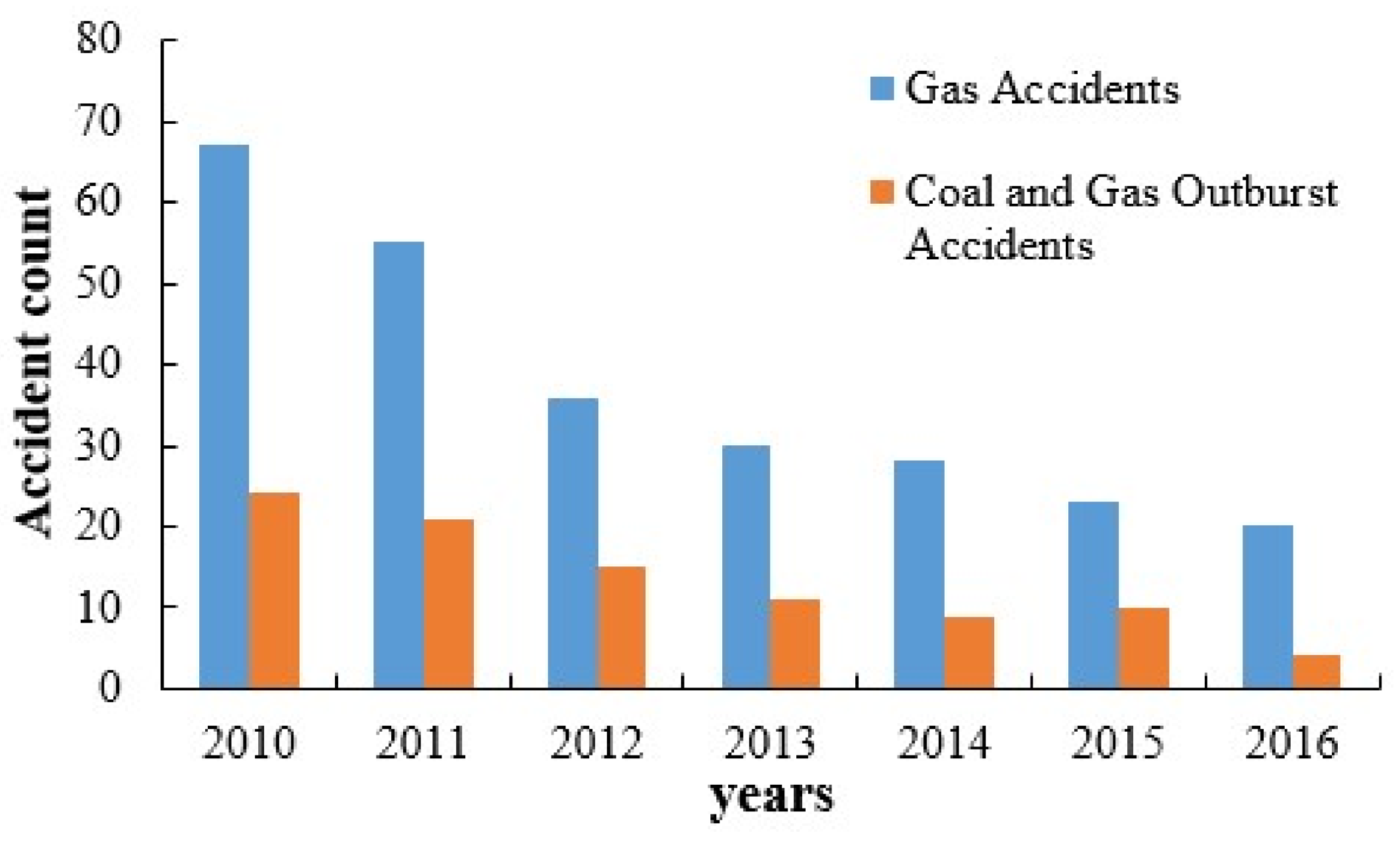
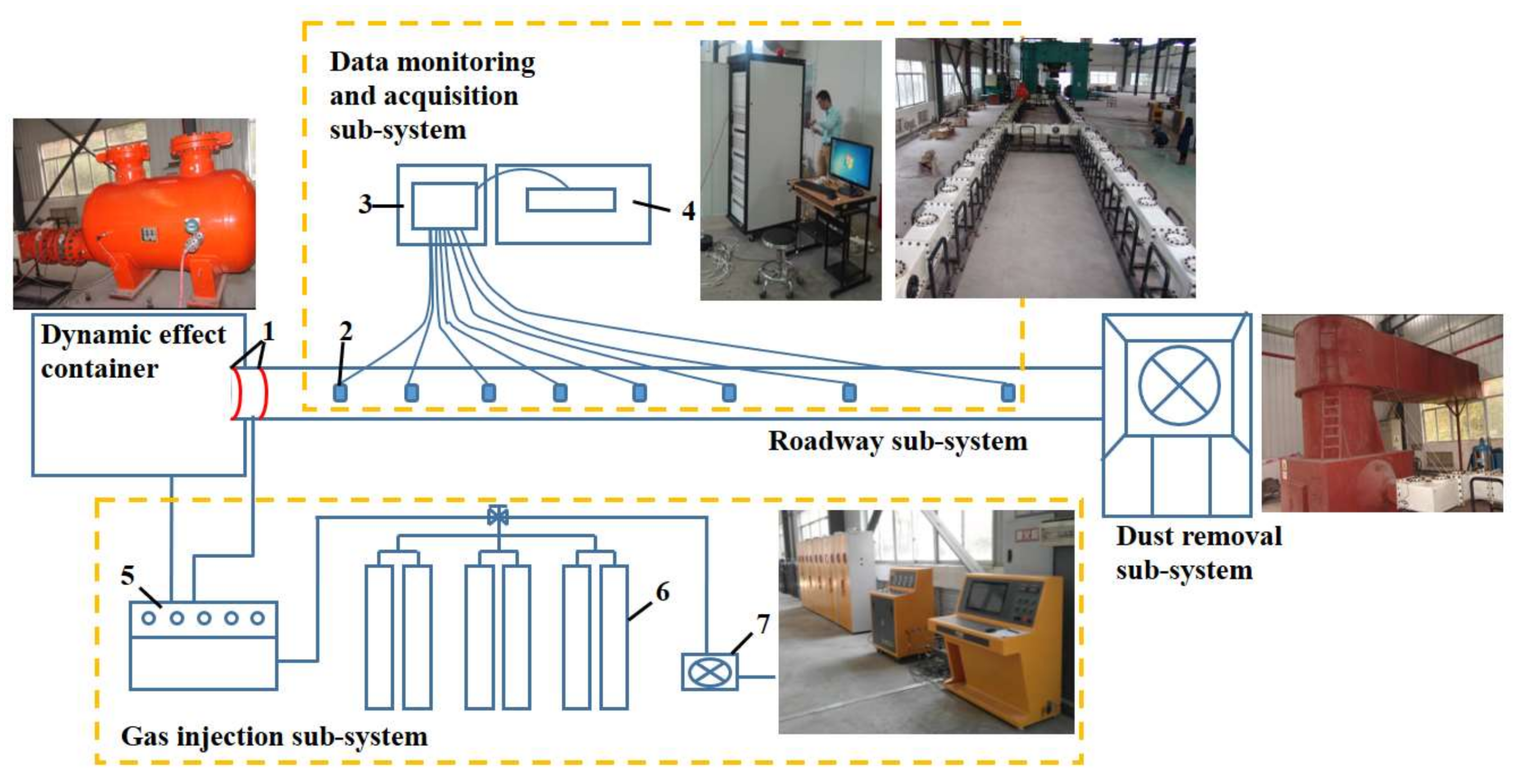

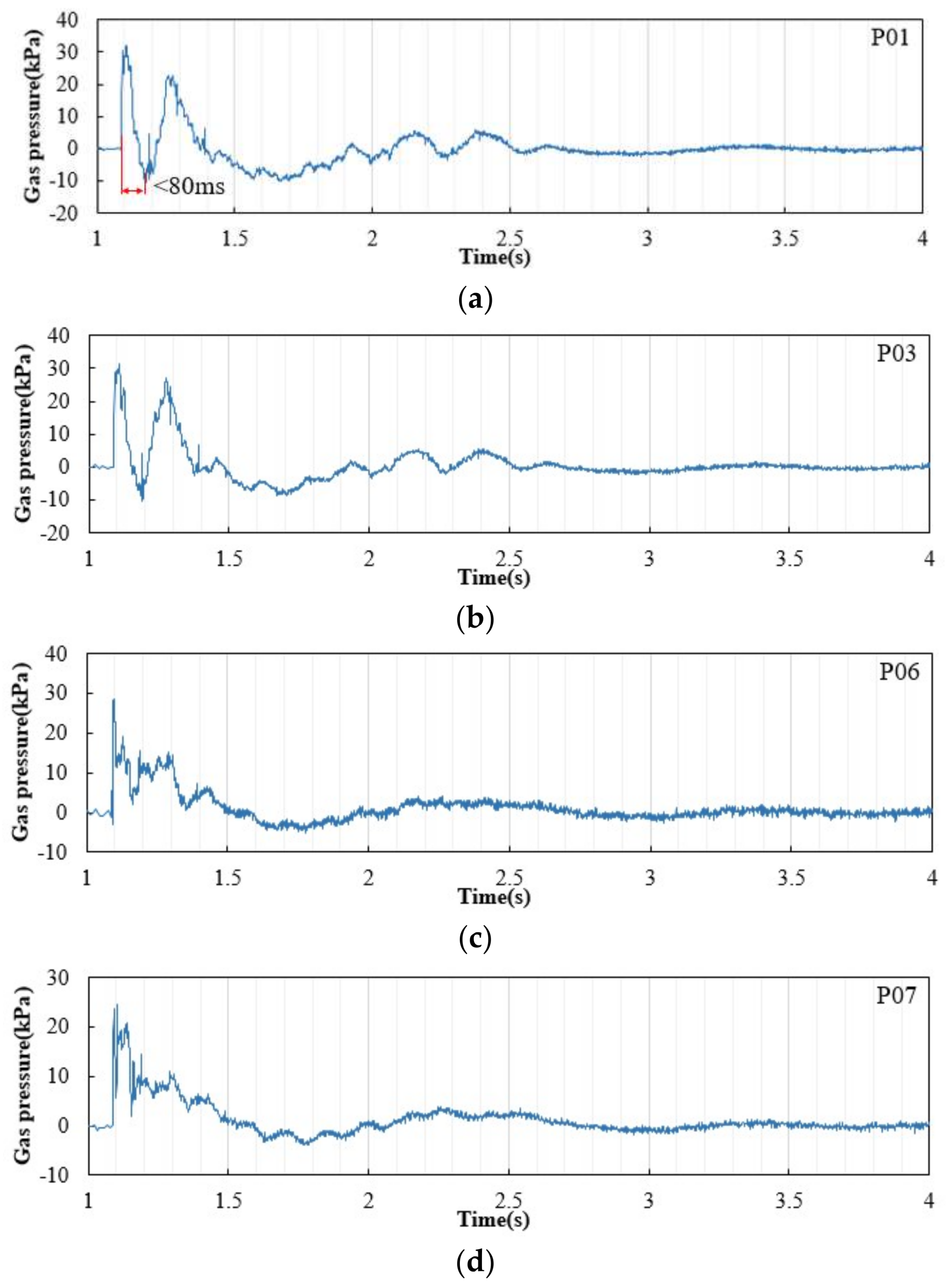


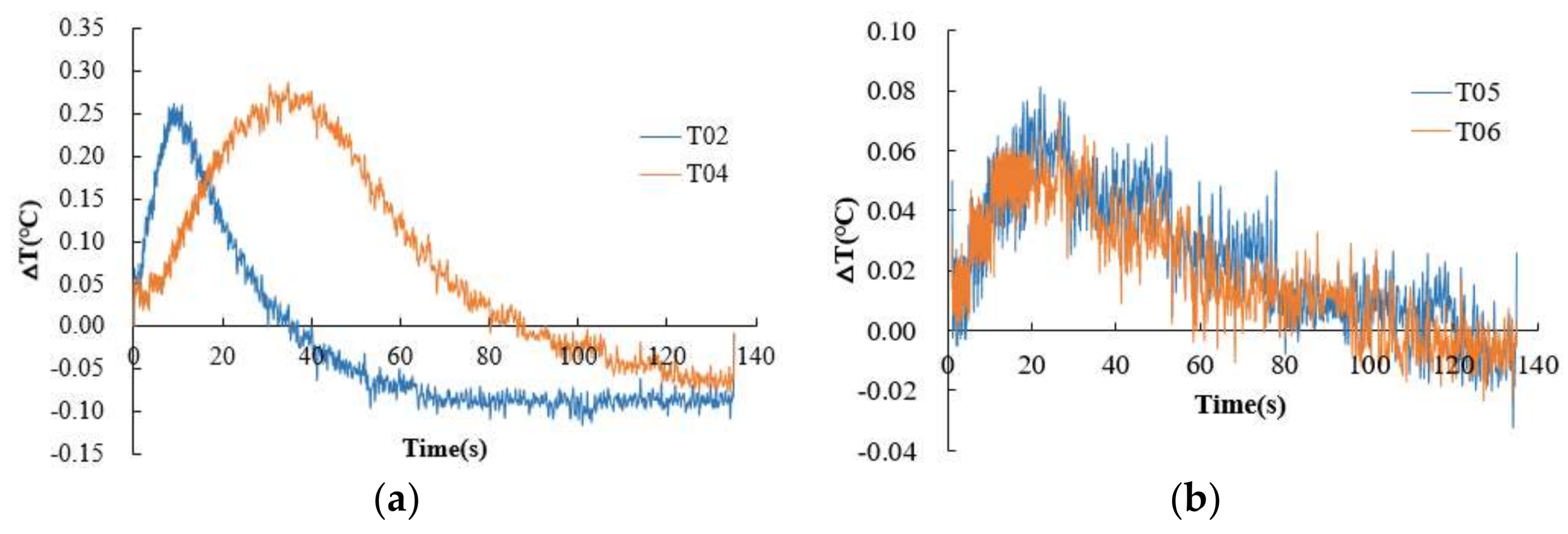
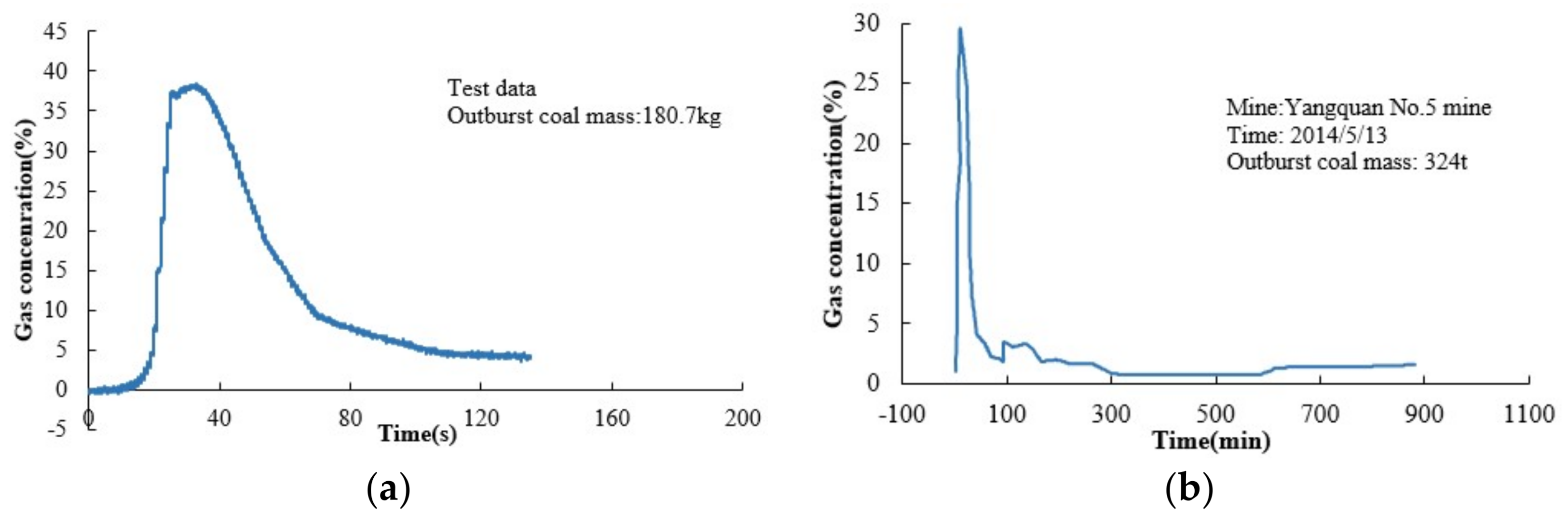

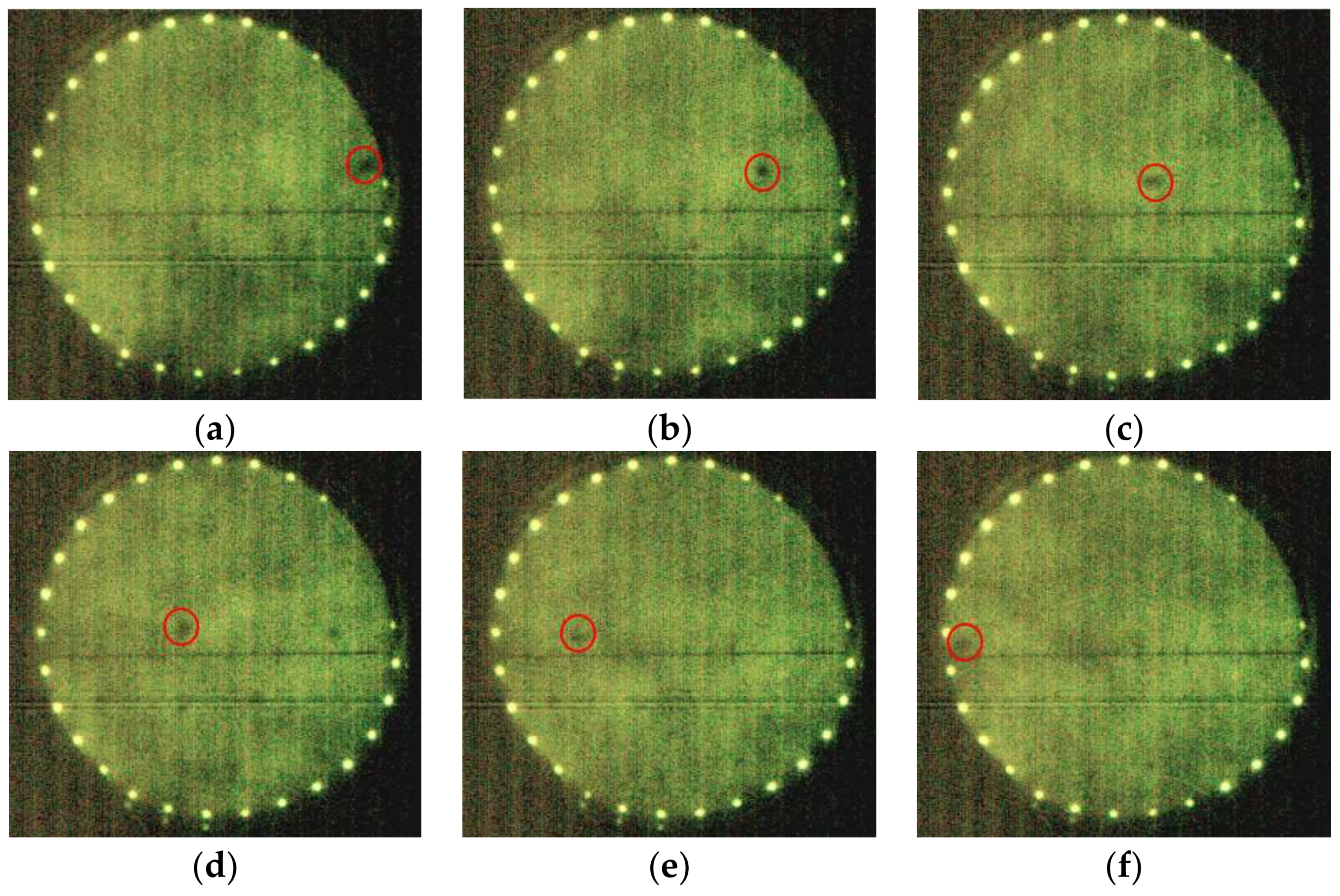
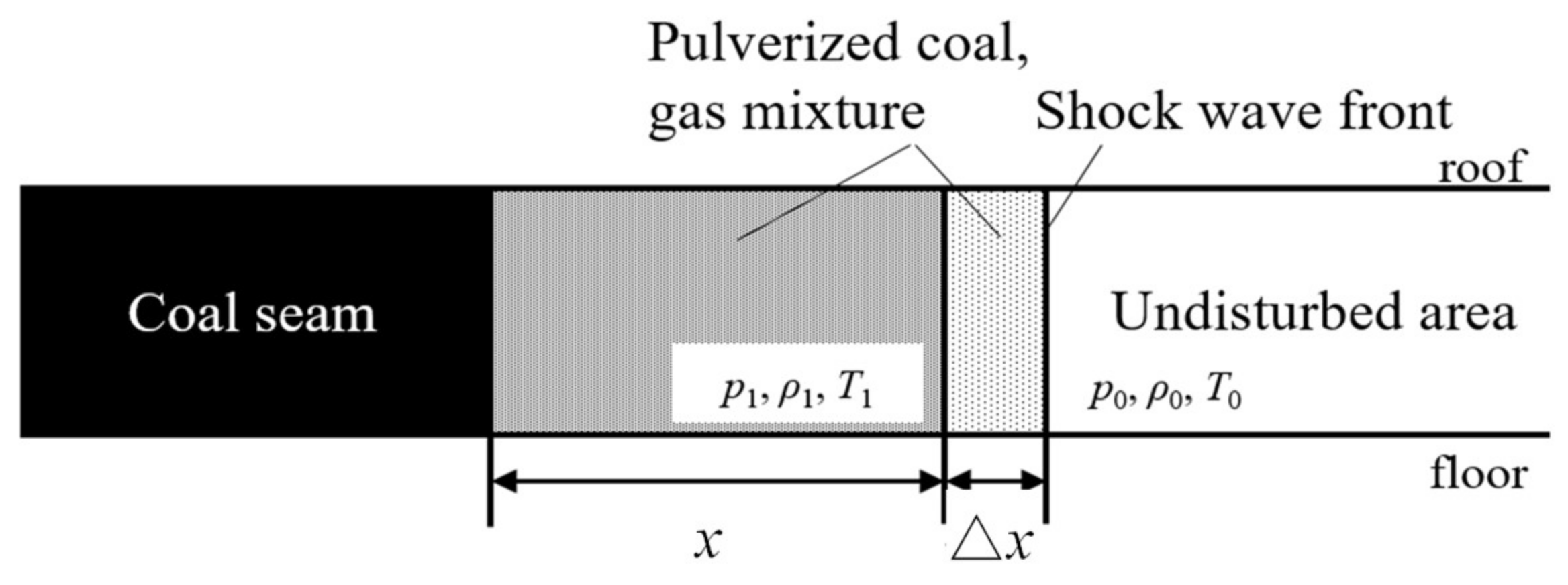
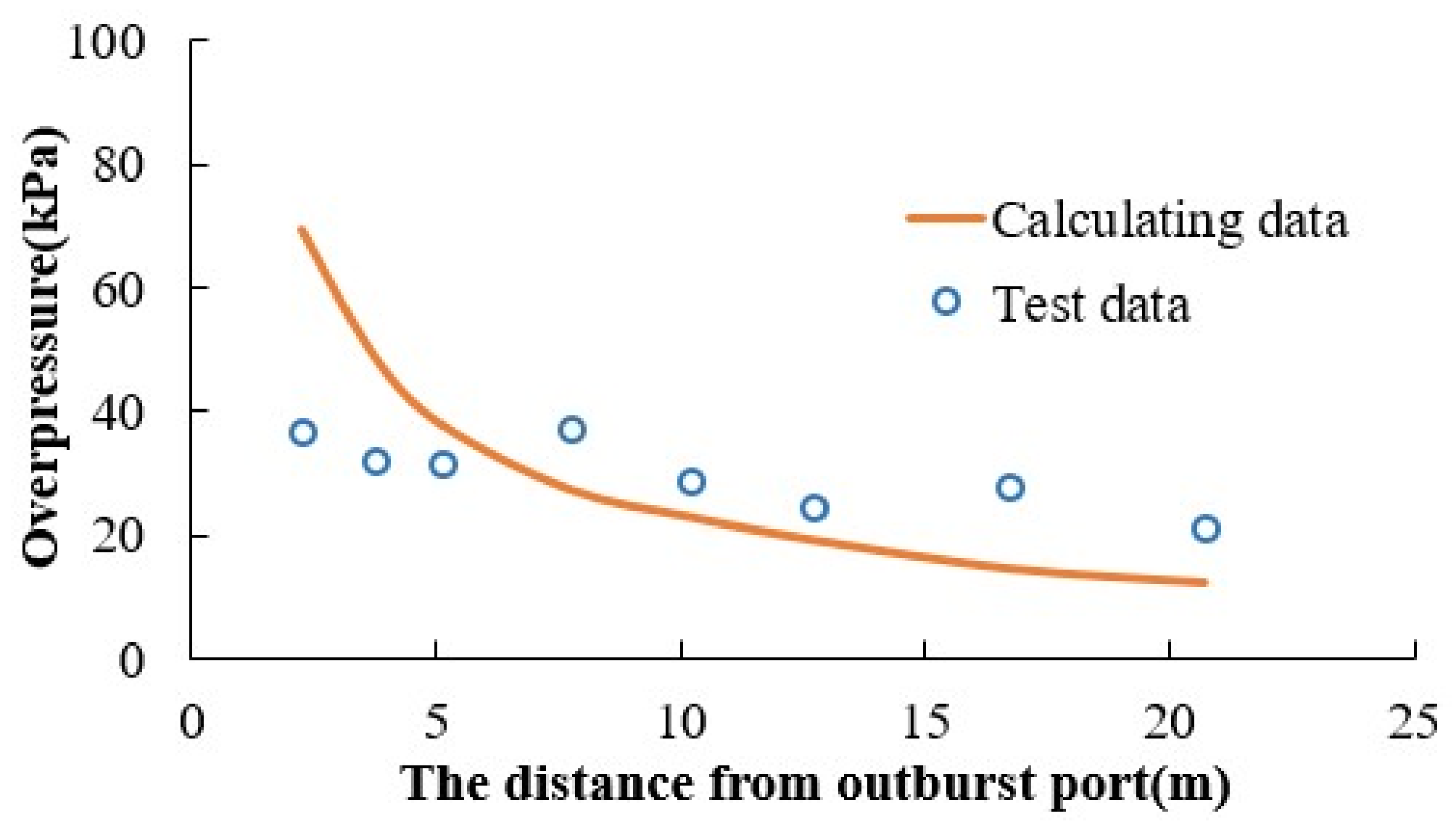
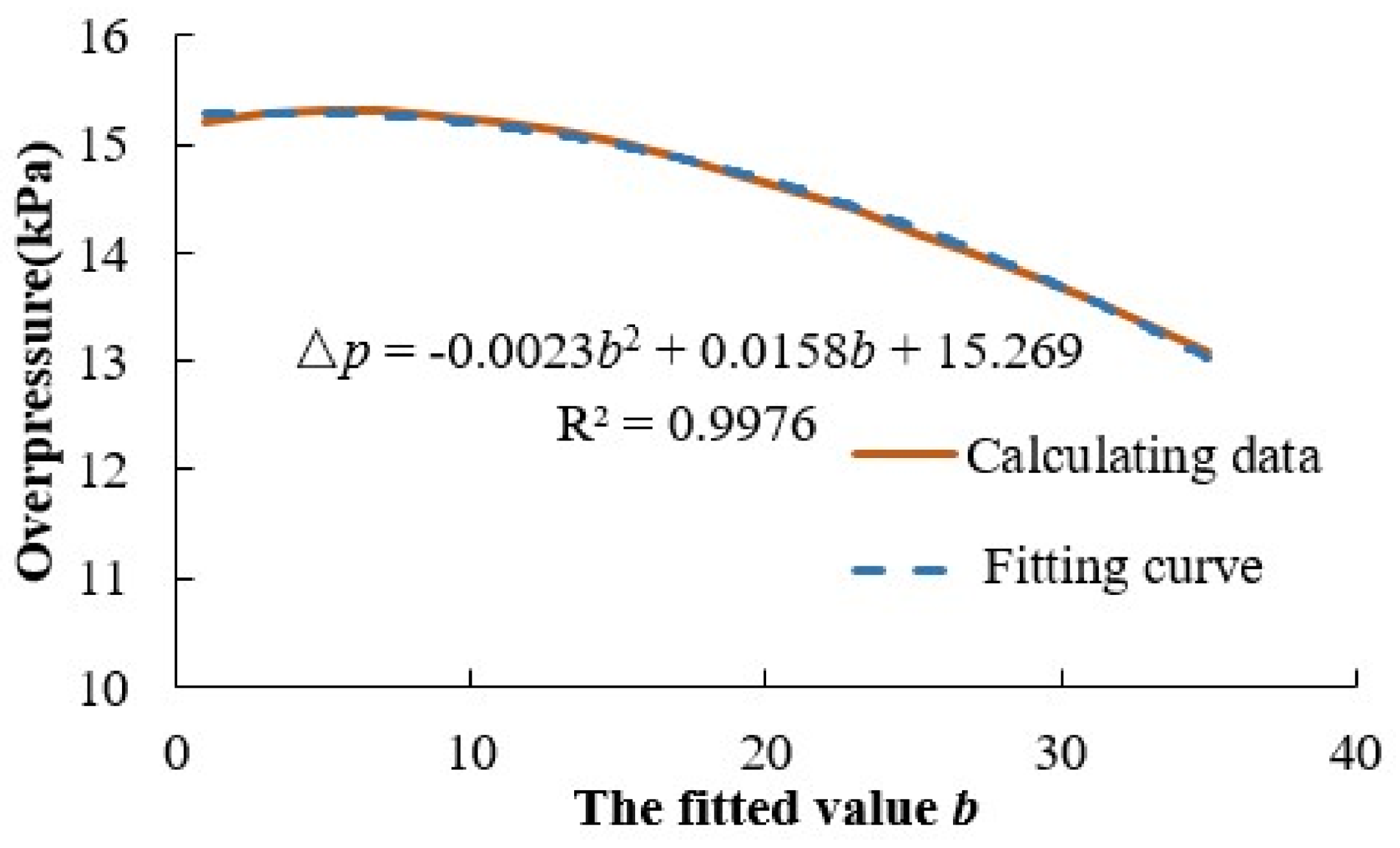
| Observation Point | Initial Frame Number | Final Frame Number | Velocity (m/s) |
|---|---|---|---|
| 1 | 5006 | 5045 | 16.82 |
| 2 | 5108 | 5161 | 12.38 |
| 3 | 5239 | 5305 | 9.94 |
| 4 | 5339 | 5399 | 10.93 |
| 5 | 5577 | 5708 | 5.01 |
© 2018 by the authors. Licensee MDPI, Basel, Switzerland. This article is an open access article distributed under the terms and conditions of the Creative Commons Attribution (CC BY) license (http://creativecommons.org/licenses/by/4.0/).
Share and Cite
Sun, H.; Cao, J.; Li, M.; Zhao, X.; Dai, L.; Sun, D.; Wang, B.; Zhai, B. Experimental Research on the Impactive Dynamic Effect of Gas-Pulverized Coal of Coal and Gas Outburst. Energies 2018, 11, 797. https://doi.org/10.3390/en11040797
Sun H, Cao J, Li M, Zhao X, Dai L, Sun D, Wang B, Zhai B. Experimental Research on the Impactive Dynamic Effect of Gas-Pulverized Coal of Coal and Gas Outburst. Energies. 2018; 11(4):797. https://doi.org/10.3390/en11040797
Chicago/Turabian StyleSun, Haitao, Jie Cao, Minghui Li, Xusheng Zhao, Linchao Dai, Dongling Sun, Bo Wang, and Boning Zhai. 2018. "Experimental Research on the Impactive Dynamic Effect of Gas-Pulverized Coal of Coal and Gas Outburst" Energies 11, no. 4: 797. https://doi.org/10.3390/en11040797
APA StyleSun, H., Cao, J., Li, M., Zhao, X., Dai, L., Sun, D., Wang, B., & Zhai, B. (2018). Experimental Research on the Impactive Dynamic Effect of Gas-Pulverized Coal of Coal and Gas Outburst. Energies, 11(4), 797. https://doi.org/10.3390/en11040797







